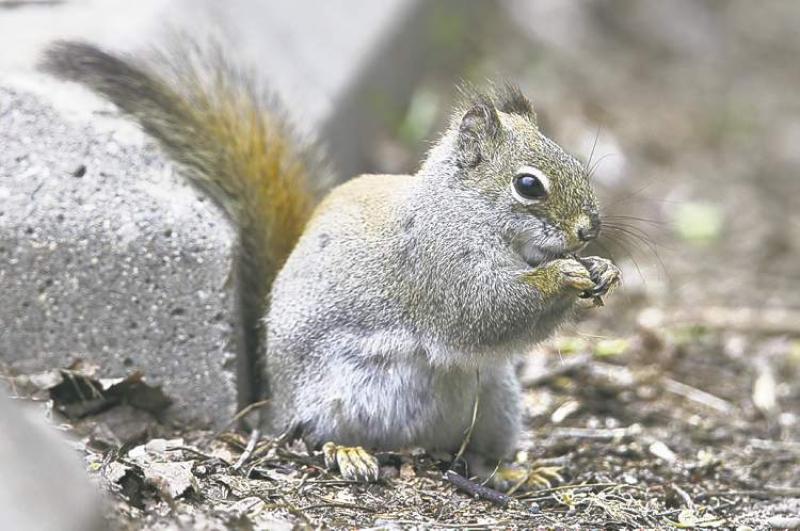QUESTION: A few years ago, you did a house inspection for me, and I think the one thing I forgot to ask was how to get squirrels out of my garage. I am sure you have probably done a column on this at some point. I have tried noise, cats, mothballs, Poulins, live trapping, all without success. -- Dianne Beaven
ANSWER: While they are cute, furry and entertaining to watch as they scamper up trees, squirrels can cause a major mess and damage to buildings if they get access. The key to eliminating them is to ensure they cannot easily get inside the structure, particularly in the winter when they like take refuge from the cold.
While you may have found it quite difficult to eliminate the pesky rodents from your garage, the answer to your dilemma is quite simple. Squirrels can claw or chew away on wood or other soft building materials to make holes big enough for them to crawl through. This is typically how they gain access to attics, eaves, crawlspaces and garages. The interesting thing is that they normally need to find damaged materials for this to occur. New or solid wood is too difficult for these critters to bore into, so finding rotting material makes life a lot easier for them. The key to preventing access is to find the damaged areas on your garage and replace them with new materials.
The first place to look is at the eaves. If you have wooden fascia and soffits, look for small holes created by the squirrels and probe all other areas with a screwdriver or sharp awl. If the probe easily sinks into the wood, it is moisture-damaged and will be easy prey for the squirrels. The only true solution is removal of the rotten wood and replacement with new material. Often, exterminators may use metal mesh to cover these holes, but that is a temporary fix. If there are large areas of damaged wood, you may consider cladding the soffits and fascia with pre-painted aluminum after replacement to eliminate the need for recurring painting and maintenance. This will improve the esthetics and also prevent further squirrel entry, as the metal will be too difficult for them to chew through.
While soffits and fascia are the most prevalent area for squirrel intrusion, other areas on the exterior of the garage may also be points of entry. Visually check all the exterior walls for moisture damage or gaps large enough for rodent entry. Passage doors, if not steel-clad, may easily become damaged, warped or off square enough to provide openings big enough for sneaky little mammals to get through. Broken windows or rotten frames are open invitations for winter refuge. Vehicle doors can have substantial gaps along the bottom due to damaged gaskets or shifting in the garage slab/driveway. Patching these holes or installation of door sweeps and weatherstripping may help with your efforts.
The last place to look is on the roof. If your garage is attached to the house, there could be rusted or missing flashing where the garage roof intersects the house walls. Deteriorated shingles may allow small openings to be enlarged for squirrel egress. Whether the garage is attached or not, take a good look at any roof vents, particularly plastic ones. If they are cracked or damaged, they can make a perfect door to the rafters inside the garage. Look underneath the lip with a mirror, or from inside the garage while standing on a ladder, to see if there are any holes. Many of these vents have small metal screens inside to prevent pest intrusion, which can be easily chewed through after they become deteriorated with age.
Once inside, squirrels can make substantial nests out of many materials. Wood shavings and fibreglass insulation are favourites, but they can also bring in twigs and spruce cones though their openings. Tarps, cardboard and other items typically stored in garages may provide excellent building materials for tree-squirrel winter housing. Check these materials carefully to see if they have been damaged or used previously for this purpose. If they are still in good condition, storing them in rigid plastic tubs with lids or other secure cabinets may prevent future damage. Finally, take any grass seed, vegetable seeds, flower bulbs or other perishable garden products and store them safely to prevent them from providing an easy food source for the rodents. I made that mistake a few years ago in my own garage and fed a good portion of the mice in my neighbourhood with grass seed for a winter.
Once you have located and replaced all the rotten or damaged building materials on the exterior of your garage, eliminating the remnants of the squirrels should not be hard. Clean up and discard any feces and nesting material and store possible sources of food to discourage a recurrence of the invasion. If you still think the critters may be hiding inside insulated walls or the attic, setting some traps or putting out poison with a built-in desiccant, after all openings are sealed, should give you peace of mind.
Ari Marantz is the owner of Trained Eye Home Inspection Ltd. and the president of the Canadian Association of Home & Property Inspectors-Manitoba (www.cahpi.mb.ca). Questions can be emailed to the address below. Ari can be reached at (204) 291-5358 or check out his website at www.trainedeye.ca .
trainedeye@iname.com




